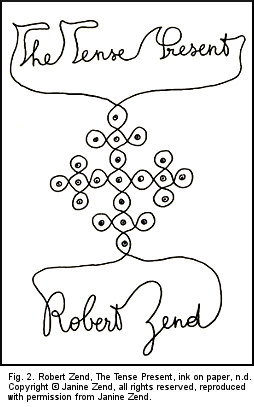
Part 1. Linelife:
Premiere of a Rediscovered Treasure
I begin my series on the life and work of Robert Zend with the presentation of a previously unpublished short visual work entitled Linelife (1983), a flip-book animation sequence of dots and lines (fig. 1) that Zend dedicated to his daughter Natalie. I was excited to find Linelife in the Zend fonds at the University of Toronto.
Fortunately, Zend left instructions for its production. Although he had drawn the images in black ink on white paper, he preferred that the colors be reversed to white-on-black. So I digitalized the images and, according to his wishes, converted them into negatives. I thought that the digital medium would enhance the animated sequence of frames, so using film editing software I gave them a time-lapse animation to imitate the effect of flipping pages. Natalie made some excellent suggestions for the most effective presentation of the work. I hope that her father would have liked Linelife in this digital incarnation.
Fig. 1. Robert Zend, LineLife, ink drawing on paper, 1983, Box 10, Robert Zend fonds, Media Commons, University of Toronto Libraries. Adapted for digital medium by Camille Martin. Copyright © Janine Zend, 1983, all rights reserved, reproduced with permission from Janine Zend.
 Although the narrative of Linelife unfolds in a geometrically abstract sequence of creation and disintegration, it also suggests an anthropomorphic trajectory of a life. And in fact, there exists a longer unpublished work entitled The Tense Present (fig. 2), which consists of the sequence of images in Linelife and interpellates text and other images to explore the arc of human life from conception to death.
Although the narrative of Linelife unfolds in a geometrically abstract sequence of creation and disintegration, it also suggests an anthropomorphic trajectory of a life. And in fact, there exists a longer unpublished work entitled The Tense Present (fig. 2), which consists of the sequence of images in Linelife and interpellates text and other images to explore the arc of human life from conception to death.
In the Linelife sequence above, which does not include that programmatic narrative, the gradual creation of a complex pattern of lines and dots could also suggest human creativity at work, and the deflation and ultimate disappearance of that triumphant pattern implies that in the cosmic order of things, art as well as life is short. Yet its very abstraction points to a more universal signification: the drama of development and decline, on microcosmic as well as macrocosmic scales. As well, the mirroring of the opening and closing suggests a cyclical pattern as things arise and fall apart in a continual succession of order and entropy.
I thought it appropriate to begin with this little gem because, although I know of no other flip-book in Zend’s oeuvre, its theme emblematizes his recurring concern with cycles of creation and destruction.

The next installment, “Dissolving Labels and Boundaries,” will explore Zend’s thoughts regarding the potentially catastrophic results of labelling people, his relationship to nationality, and aspects of his cosmopolitanism.
If you’d like to receive notification of these installments on Robert Zend, please use the email subscription feature to the upper right. And please kindly spread the word to anyone who might be interested. Your comments and feedback are most welcome.
Next Installment: Part 2.
Dissolving Labels and Boundaries
Camille Martin
Thanks for bringing this back to life!
LikeLike
Glad you liked it, Carol!
LikeLike
Pingback: Robert Zend (1929-1985): Poet without Borders – Preface with Portraits | Rogue Embryo